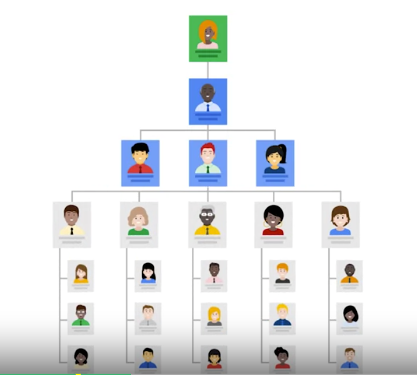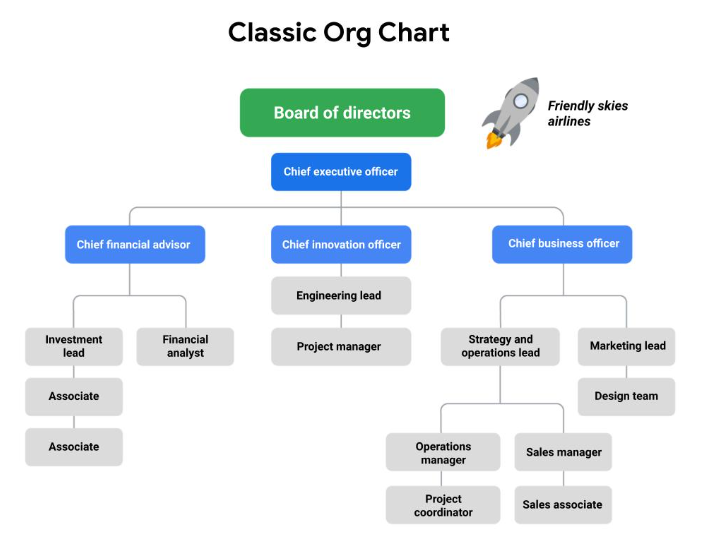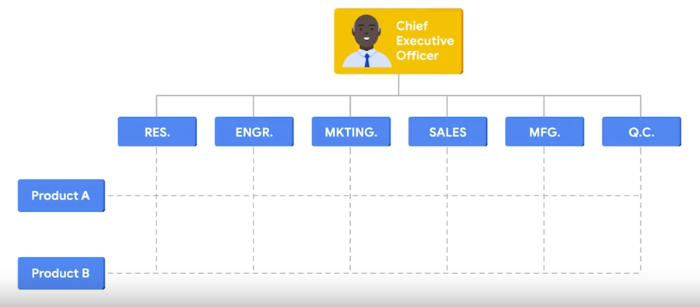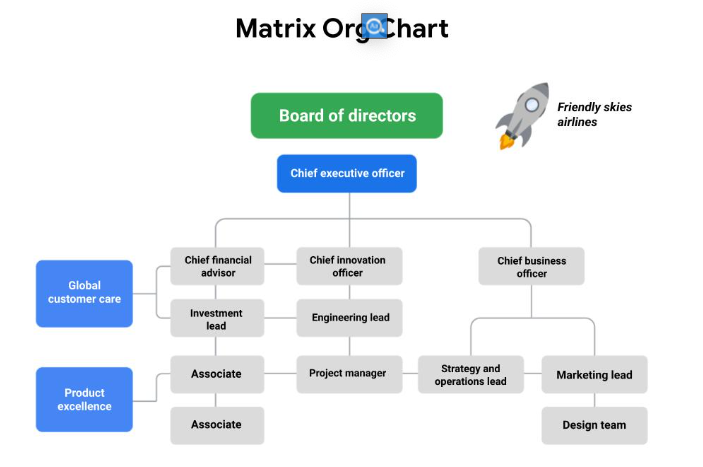Organization Structure and Culture
Organizational Structure
Organizational Structure: The way a company or organization is arranged
- How job tasks are divided and coordinated
- How all the different members of the organization relate to one another
(“who reports to who”)
Understanding the different types of organizational structures can serve as a map to help you determine where you fit in, who you should communicate with, and how frequently to communicate with them. It can also help you navigate within the organization when you need support or need to determine who has authority in a certain situation.
Classoc and Matric structures
An organization’s structure is most commonly mapped out using a reporting chart or “organizational chart” (“org chart”), which shows the relationship between people and groups within the organization, and details who each person or group reports to.
Classic: Functional or top-down structures

A Chief Executive Officer (CEO) has direct authority over several department managers. The department manager has direct authority over several other sections of employees.
- This system requires communication both up and down the ladder. In a Classic structure, authority comes from the top and filters to the bottom.
- Frequent reporting of project status updates may be required to pass up through management levels to keep higher leaders informed.
Also referred to as functional organizations because the organization is divided into departments based on function
Each department is led by a functional manager, and employees are grouped according to the functions of their role.
Example

If you are a project manager in this type of structure, you need to
- consult with functional managers to understand your resources and the capacity of each teammate
- familiarize yourself with each function’s internal processes and approval structure
- communicate regularly with your manager, the person directly above you, and also with your peers who work on the same types of projects as you.
Matrix: Direct higher-ups and stakeholders from other departments or programs

- Employees have two or more managers
- Think of a Matrix structure as a grid where you still have people above you, but you also have people in adjacent departments who expect to hear updates on your work progress
- Functional areas tend to cross paths more frequently, and depending on the nature of the work, the responsible manager for each area has the most authority.
- Example

How organizational structure impacts project management
- The amount of authority given to the project manager
- Resource availability
| Classic | Matrix | |
|---|---|---|
| Authority | Less authority and a tighter scope -> need to rely on getting approval from the appropriate managers, directors, and department heads | Need to cooperate with more than on e leader in the organization -> Make sure you have identified and communicated with anyone you might need to report to and get approval from well before the project begins |
| Resource | May need to share resouces and negotiate priorities (Key: make sure you know who your stakeholders are and who controls what) |
Project Management Office
Within both of classic and matric structures, there is sometimes a group devoted specifically to project management in the organization: the Project Management Office (PMO).
A Project Management Office, or PMO, is a group within an organization that defines, sets, and helps maintain project management standards and processes throughout that organization. It often acts as a coordinated center for all of the organization’s projects, helping them run more smoothly and efficiently.
Function of PMO
Strategic planning and governance
Involves defining project criteria, selecting projects according to the organization’s business goals, and then providing a business case for those projects to management
Best practices
- Help implement best practices and processes within their organization
- Share lessons learned from previous successful projects
- Help ensure consistency among their organization’s projects by providing guidance about processes, tools, and metrics
Common project culture
- Help set common project culture practices by training employees about optimal approaches and best practices
- Help keep project management practices consistent and efficient across the entire organization
Resource management
- Help define the roles and responsibilities needed on any given project
- Provide training, mentoring, and coaching to all employees, but project managers in particular
Creation of project documentation, archives, and tools
- Invest in and provide templates, tools, and software to help manage projects
- Play an important role in maintaining their organization’s project history
Impact of Organizational Culture
Organizational culture
An organization’s culture provides context and acts as a guide for what their people value, how they operate on a daily basis, how they relate to one another, and how they can be expected to perform.
Importantce of organization culture
Identity
- An organization’s culture defines its identity. Its identity essentially describes the way the company conducts business, both internally and externally.
- The mission and value statements will help you understand why the company exists and will give you insight into what the company believes in and how it will behave.
People
- Strong, positive organizational culture helps retain a company’s best employees.
- People who feel valued, engaged, and challenged are more likely to give their best and want to drive for success.
- It is important to find an organization with a culture that fits your personality.
- One way to find out more about an organization’s culture is to talk to the people who work there.
- You can also take note of the current employees’ attire, expressions, and overall behavior.
Process
- It is important to find an organization with a culture that fits your personality. One way to find out more about an organization’s culture is to talk to the people who work there. You can also take note of the current employees’ attire, expressions, and overall behavior.
- The organization’s culture is instilled throughout the company—from its employees to how its employees do their job.
Understanding an organization’s culture (mission and value) will help you navigate your team more effectively toward achieving the project’s goal. It also impacts the way you plan your project. -> You’ll need to be familiar with an organization’s culture, so that you can minimize conflict and complete the project with as much support and harmony as possible.
Navigating culture
Ask questions
You can learn about an organization’s culture by asking questions of management and peers. It can be helpful to ask these questions in the interview phase to better understand the company’s culture before accepting a position. It also shows the interviewer that you’re knowledgeable about the impact culture can have on a project. You might want to ask questions about:
Atmosphere
- What is the company’s dress code?
- How do people typically share credit at this company?
- Is risk-taking encouraged, and what happens when people fail?
- How do managers support and motivate their team?
- How do people in this role interact with customers and users?
- When and how do team members give feedback to one another?
- What are some workplace traditions?
- What are some of the ways the company celebrates success?
Policies
- What are the policies around sick days and vacation?
- Does the company allow for employee flexibility (e.g., working from home, flexible working hours)?
- What policies are in place that support employees sharing their identity in the workplace?
Processes
- What is the company’s onboarding process?
- How do employees measure the impact of their work?
Values
- What are the company’s mission and value statements?
- How might the person in this role contribute to the organization’s mission?
- How does the organization support professional development and career growth?
Listen to people's stories
Listening to what current employees have to say and how they portray the company will give you great insight.
- What were employees’ experiences with similar projects in the past?
- What can they tell you about key stakeholders and customers?
Take note of company rituals
Rituals can be powerful drivers of culture. They engage people and help instill a sense of shared purpose and experience.
- How are birthdays and holidays celebrated?
- Do employees generally eat lunch at the same time and in the same place?
- Watch employee interactions**:** Observing how employees interact can help you tailor your interaction style to the company norm.
- Are employee interactions more formal or informal in nature?
- Are ideas solicited from employees in different roles?
Make observations
Understand your impact
Sharpen your communication skills
To communicate effectively, you will need to understand how to navigate the different channels in your company. Ask questions about communication practices when you start a new role such as:
- Is it customary to sign emails from the team rather than from you individually?
- Should presentations include team members or be solely presented by the project manager?
This can help you make sure you are adhering to expectations.
Change Management
Change management: The process of delivering your completed project and getting people to adopt it.
When you understand change management and your role in the process, it can ensure a smooth roll out of changes and easier adoption.
Core concepts:
Create a sense of ownership and urgency
- Ownership means getting others to feel they are empowered to take responsibility for the successful completion of their tasks.
- Urgency means getting them to understand that the project is important and to identify what actions need to be taken to move the project along.
Figure out the right combination of skills and personalities
- One effective way of motivating your team is to communicate clearly your vision and approach for the project.
Effective Communication
- Having effective communication with your team means being transparent and up front with your plans and ideas and making information available.
- Deal with resistance or roadblocks once the project is complete:
- helping folks adjust
- rewarding their efforts
- reminding them of the overall value the project is providing long-term
Deal with resistance or roadblocks once the project is complete:
- helping folks adjust
- rewarding their efforts
- reminding them of the overall value the project is providing long-term
Integrating project management and change management
Both change management and project management aim to increase the likelihood of project success. They also incorporate tools and processes to accomplish that goal. The most effective way to achieve a project goal is to integrate project management and change management, and it is your responsibility as a project manager to do so.
Begin by asking yourself the following questions:
- How will the organization react to change?
- Which influencers can affect change?
- What are the best means of communication?
- What change management practices will lead to the successful implementation of my project?
The answers to these questions will help you prepare for a variety of possible scenarios and allow you to craft solutions to effectively support the adoption of your project.
Best practice:
Be proactive
- Incorporate change management into your project management steps.
- For example, you can schedule time during team meetings or create a feedback document to ensure that your team members know there is a place to voice their suggestions and concerns.
- Plan steps towards the end of your project to introduce the deliverable to stakeholders in the form of demonstrations, question and answer forums, or marketing videos. You can factor all of these decisions into your plan so that any potential changes are less likely to impact your timeline.
Communicate about upcoming changes
Communication should occur regularly among impacted stakeholders, the change management team, and the project team.
Check in and communicate throughout the project about how the changes will provide a better experience for end users of the project deliverables.
-> In this way, you support the process by providing everyone with the information they need to feel prepared to adjust to changes once the project is ready to launch.
Follow a consistent process
- The change management process should be established and documented early on in your project to guide how the project will handle change.
- Your organization may also have an overarching change management plan that can be adopted for your project.
- when the promotion of the change should happen
- when training should occur
- when the launch or release will occur, and
- corresponding steps for each phase of the process.
Practice empathy
Use tools
Incorporating tools to assist in the adoption of a change can be very helpful.
- Feedback mechanisms, such as surveys, can capture input from stakeholders.
- can visualize the project’s development process.
- can illustrate the company’s culture and how the company’s values, norms, and employees behavior may be affected by the change.
For more on how to participate in the change management process, check out the following resources:
Participating in change management
Participating in change management involves
- Being empathetic to the challenges of the change management process
- Supporting necessary changes throughout the project life cycle
Ask yourself questions that will inform change management
Wow will the organization react to change?
Which influencers can affect change?
What are the best means of communication?
What change management practices will lead to the successful implementation of my project and so on?
Answers to these questions will help you prepare for a variety of possible scenarios, and craft solutions to effectively support the adoption of your project. They will also help you navigate possible challenges along the way and lead your project through a successful change management process.
Corporate and project governance
Governance in business is the management framework within which decisions are made and accountability and responsibility are determined. In simple terms, governance is understanding who is in charge.
Corporate governance: Own set of standards and practices of each organization that direct and control its actions.
- The framework by which an organization achieves its goals and objectives
- A way to balance the requirements of the various corporate entities, such as stakeholders, management, and customers.
- Affects every part of an organization, including action plans, internal and external controls, and performance measurements.
Governance and change management go hand-in-hand. To successfully implement change management, it is essential that you understand the structure and culture of the organization. Effective governance in change management provides clearly defined roles and responsibilities during change.
-> This enables the people within the organization to have a precise understanding of who makes decisions and of the relationship between those managing and participating in the change management process.
Another example of governance within an organization is the creation and use of steering committees.
- Decide on the priorities of an organization and manage the general course of its operations.
- Act as an advisory board or council to help the project manager and the company make and approve strategic decisions that affect both the company and the project
Project governance: the framework for how project decisions are made
- Helps keep projects running smoothly, on time, and within budget
- Involves all the key elements that make a project successful
- Tells you what activities an organization does and who is responsible for those activities
- Covers policies, regulations, functions, processes, procedures, and responsibilities.
How project and corporate governance intersect?
Project governance needs to be tailored to your organization’s specific needs, which will influence how you implement and monitor the governance framework on your project. Effective project governance ensures that an organization’s projects are aligned to the organization’s larger objectives, are delivered efficiently, and are sustainable. This includes:
Considering the long- and short-term interests of your organization
Making thoughtful decisions about which projects to take on and avoiding projects if you do not have sufficient resources
Providing timely, relevant, and reliable information to the board of directors and other major stakeholders
Eliciting the input and buy-in of senior managers since they are the decision-makers
During the initiation phase, prioritizing clear, reachable, and sustainable goals in order to reduce confusion and conflict
During the planning phase, assigning ownership and accountability to an experienced team to deliver, monitor, and control the process
During the execution phase, learning from mistakes and adapting to new or improved knowledge
Corporate governance can involve clearing many hurdles before making decisions that can influence not only a single project, but the entire corporation. At the same time, corporate governance can help support project governance, as it provides oversight on compliance and mitigating risk and offers guidance and direction for project managers. Good corporate governance can also help project managers secure resources, get issues addressed, avoid delays in decision-making, get buy-in from stakeholders, and achieve visibility for projects on the executive level.